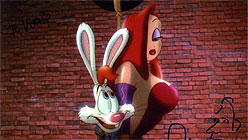“I can give you stars!” Roger protests, hitting himself on the head with a spontaneously appearing frying pan, which produces, unfruitfully, bells then butterflies. The director calls lunch.

And thus are we introduced to this alternate reality, where cartoon rules apply, at least for cartoons. In this world, when Dumbo appears flying around the movie lot, a studio head explains, “I got him on loan from Disney.” In this world, when you order a scotch on the rocks in a toon bar, you’d better add “and I mean with ice!” lest your waiter take you literally. And in this world, when a toon’s wife is cheating on you by “playing pattycake” with another man, that description is not a euphemism. One of the most compelling elements of Roger Rabbit is that no joke is wasted; each adds another layer to our understanding of the emotional life of the animated folk and their complex relationship with humans.
That sort of efficiency permeates the script, which has private eye Eddie Valiant (Bob Hoskins), a boozer whose career turned sour after his brother was done in by a piano-dropping toon, becoming embroiled in a murder mystery involving the rabbit, a will, and an insidious corporate conspiracy.

Classic film tropes abound, each with its own sillified twist punctuated by snappy dialogue. The animated femme fatale Jessica Rabbit, a member of the rodentia family by marriage only, calls to mind a slower-burning Rita Hayworth in Gilda. Built — or rather drawn — to mesmerize men into a sex daze, she pleads her innocence to Eddie with the highly quotable: “I’m not bad, I’m just drawn that way.”
Casablanca, The Maltese Falcon, Vertigo, and especially Chinatown — Roger Rabbit borrows from them all. There’s even a great bit of economical storytelling lifted from Rear Window, in which we’re brought up to speed on Eddie’s entire history solely through photographs and newspaper clips.
The technical virtuosity is even more impressive. As director Zemeckis recently explained on Fresh Air, the animators devised a process that endowed each cel with the same lighting as in the corresponding live-action scene. The film also breaks a longstanding rule of hybrid human-cartoon projects by allowing the camera to roam. In films like Mary Poppins, Zemeckis said, the recording device was always static “because it would be so difficult to draw different changes of perspective as the camera moves.” But he shot the film “like I would any live action movie. And the animators actually found that it worked better by having the camera moving. That they were able to actually give more life to the cartoon characters and have them feel like they’re more integrated into the actual two-dimensional set.”

That visual integration of man and toon functions as a jarring counterpoint to their respective places in the movie’s fictional society. It’s an audacious stroke that the very word “toon,” whenever mouthed, sounds just shy of a racial slur. When the film’s villain, Judge Doom (Christopher Lloyd), makes the ominous pronouncement that “a human has been murdered by a toon,” it doesn’t take much to imagine him subbing in the letter c for the beginning consonant of that last word.
There’s more than a little sense here that toons occupy the same socioeconomic position, and are viewed with the same potently racist mixture of fascination, paternalism, and fear, as African Americans in the real-life period portrayed. It’s possible, in fact, to fault the film for playing a bit too fast and loose with that substitution, to the point where it’s willing to trade on those stereotypes without necessarily shattering them. For instance, toons are playful, joyous and good box office, but they’re also mercurial, anarchic, and physically dangerous; after all, they enjoy the more forgiving laws of physics that apply within the animated world. The toons even live in their own walled-off area, Toon Town, though if a human wants to take a walk on the wild side, he can mix with them at an underground nightclub where top stars like Donald and Daffy Duck moonlight as performers. (Perhaps the biggest transgressive thrill in this milieu: animated inter-studio mingling.) The toons, in fact, pack the repressed power of an underclass, and if they were ever released from their servitude as manufactured entertainment, there’s no telling what they might do. (The story even presses the analogy to real-world otherness by using genocide as a plot point. How do you like that in your top-grossing animated films?)
The denouement provides the movie’s final alternate-universe thrill. It turns out Judge Doom has been buying up land and L.A.’s mass transit system, which he intends to dismantle, because he wants to build a freeway. What’s that? Eddie wants to know. Here’s Doom’s explanation, delivered by Christopher Lloyd with all due visionary megalomania:
“Eight lanes of shimmering cement running from here to Pasadena… I see a place where people get on and off the freeway, on and off, off and on, all day, all night. Soon where Toon Town once stood will be a string of gas stations, motels, restaurants that sell rapidly prepared food, tire salons, automobile dealerships, and wonderful, wonderful billboards reaching as far as the eye can see. My god it’ll be beautiful.”

This revelation has its roots in what some have claimed to be a real car company conspiracy, paving the way, literally, for the autocentric dystopia that many find L.A. to be today. In the film however, the plot is foiled, and the finale trots out dozens of cartoon familiars sending our heroes off into a dazzlingly luminescent animated landscape, and serenaded with the Toon Town anthem: “Smile, darn ya smile, you know this great world is a good world after all…”






